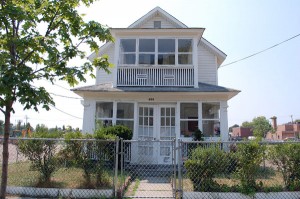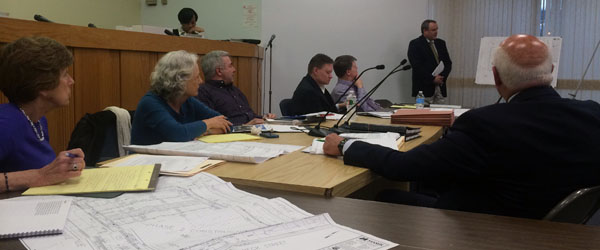iStar and K. Hov get committee input for South Grand project
TRC members concerned with Monroe and Sewall streetscapes
Representatives from waterfront redeveloper iStar Financial and K. Hovnanian homes presented their plans to build 27 town homes on the western edge of the waterfront redevelopment zone to the city’s Technical Review Committee [TRC] last week.
The proposed project — called “South Grand” — includes three row-like structures consisting of nine units each built along the western portion of the block bordered by Sewall and Monroe and Grand avenues. Development of the eastern portion of the block will have to wait until iStar can acquire the last remaining lot on the site.
The TRC is the first step in the approval process for new development in the waterfront redevelopment zone. The committee reviews whether a project meets certain specific design standards, makes recommendations to developers and provides comments to the Planning Board before the project is presented to the full board for review. The TRC is advisory only. The City Council also must approve the project.
“Brian Cheripka [iStar’s vice president of land] and I have been working hard to make this particular phase work for Asbury Park, as well as future projects coming up,” said Barry Mccarron, president of K. Hovnanian’s northeast division, at the TRC meeting last Wednesday.
IStar is the majority owner of Asbury Partners which owns the land and the development rights to the site. Hovnanian and iStar have an agreement for the home builder to construct the development. IStar is responsible for obtaining the approvals.
 “This is a very unusual project for Asbury redevelopment area,” said TRC member Fredrick Heyer, one of the city’s planning and development consultants. “Small-scale subdivision – taking nine unit bites out of a block is something that is uncommon in Asbury.”
“This is a very unusual project for Asbury redevelopment area,” said TRC member Fredrick Heyer, one of the city’s planning and development consultants. “Small-scale subdivision – taking nine unit bites out of a block is something that is uncommon in Asbury.”
“I understand there is a business deal, I think, that is driving … this project into manageable chunks,” Heyer said, expressing concern that the business deal was controlling the design.
The subdivision of the property and two-phase development is to accommodate one lot on the block that iStar has not yet acquired, representatives of the developers said. Long-time Asbury resident Angie Hampilos still owns the lot at 406 Sewall Ave [shown at right.]
IStar continues to “make diligent efforts to acquire the property but have been unsuccessful so far,” said iStar attorney Frederic P. Laventhal.
While iStar, through Asbury Partners, has the right to take the property by eminent domain, iStar has decided not to go that route out of respect for the property owner, according to iStar spokesman Roger Ardan.
Plans for the second phase of development have not been released and will have to wait until Asbury Partners owns all of the land on the eastern end of the block, according to the project’s application submitted to the TRC.
 Brick facades with cementitious material on the sides and the rear of the buildings achieve a “neo-traditional, urban inspired modern town home,” said Joseph Lipanovski, an architect for K. Hovnanian.
Brick facades with cementitious material on the sides and the rear of the buildings achieve a “neo-traditional, urban inspired modern town home,” said Joseph Lipanovski, an architect for K. Hovnanian.
The waterfront redevelopment plan refers to the area where South Grand is proposed as a link from the downtown to the boardwalk beach area that take its cues from the surrounding architecture.
“We believe these designs achieve these goals of the city,” Lipanovski said.
But members of the TRC said the sides of the building lack useful design elements, and the streetscapes along Monroe and Sewall avenues will not be the vibrant, pedestrian-friendly areas called for in the waterfront redevelopment plan.
“I don’t object to the townhouse approach along Grand [Avenue] but you put a fake box out there that has no depth,” said TRC and planning board member Sarah Ann Towery, a retired architect.
She and Councilman John Moor, who also sits on the planning board, both expressed dislike for the Monroe and Sewall avenue streetscapes.
“You are pretending it is a bay window,” Towery said. “You are trying to give some movement to something that is basically a flat façade.”
“The plan calls for the entire block to be pedestrian friendly, and is Sewall and Monroe being pedestrian friendly just showing the butt end of the building?” said Moor.
“I think it is going to be very ugly,” said Towery. “That is the biggest objection I have.”
“It comes down to orientation again,” said Heyer. “We are trying to dress up a façade that we’re not supposed to be able to see.”
Towery is also concerned about how long the back of the third building will be in exposed view while iStar works to obtain the land from Hampilos.
“Frankly, we would like to get moving [on the project],” said Laventhal.
“The issues regarding aesthetics will be considered, but at the end of the day as long as it is [waterfront] plan compliant we can move forward,” he said
The orientation of the buildings is not something iStar is willing to negotiate, Laventhal said.
Moor also said that a minimum of two design architects are required for each development project along the waterfront, and questioned why there was only one used for South Grand.
Keenan Hughes, a planner for Asbury Partners, said that since the project was split into two phases, a second design architect will be used for the eastern area of the block.
After the two-hour presentation, Moor seemed taken aback by iStar’s rejection of his request that it return to the TRC with an updated plan to address the committee’s concerns. Although it is not required, iStar is the first applicant that refused to come back before the committee, director of planning and redevelopment Donald Sammet told the TRC.
Laventhal instead requested the TRC submit a list of its concerns in writing to be addressed by representatives from iStar, who will determine if there is a solution to be had and offer it up if there is, he said. Laventhal cited the advisory nature of the TRC, and that the Planning Board would ultimately decide the application, as the reasons that no further appearances are needed.
 The application will need two bulk variances from the Planning Board for lot area and lot frontage, according to iStar engineer Robert Curley.
The application will need two bulk variances from the Planning Board for lot area and lot frontage, according to iStar engineer Robert Curley.
The townhouses will be three and four story units, with living space of approximately 3,000 square feet.
If the project receives final approval, it will mark the first time a national home builder has entered the Asbury Park market since the waterfront was originally designated as a redevelopment area in 1984, according to a previous statement from iStar.
————————————————————
Follow the Asbury Park Sun on Facebook and Twitter.















